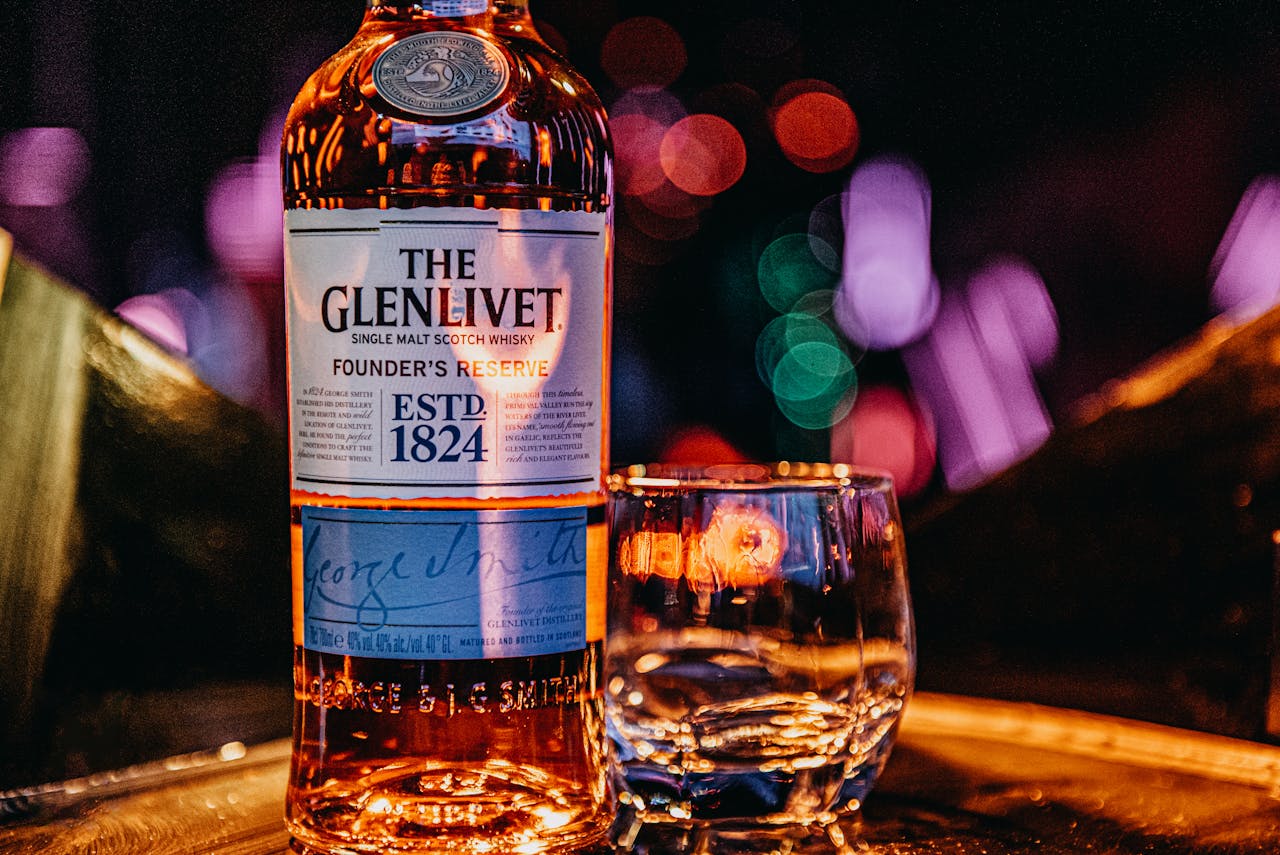What is Scotch Whisky?
Scotch whisky is a distilled alcoholic beverage made from malted barley, water, and yeast. To be classified as Scotch, it must meet several key criteria:
- Made in Scotland: To be called Scotch, whisky must be produced in Scotland.
- Aged in Oak Barrels: Scotch must be matured in oak casks for a minimum of three years.
- Alcohol Content: It must be distilled to an alcohol content below 94.8% ABV (Alcohol by Volume) and bottled at no less than 40% ABV.
- No Additives: The only permitted ingredients are water, malted barley (and in the case of grain whisky, other grains), and yeast. Colouring from caramel is allowed, but no other additives are permitted.
Types of Scotch Whisky:
There are five main categories of Scotch whisky, each with its own characteristics and production methods:
- Single Malt Scotch Whisky: Made from 100% malted barley and produced at a single distillery using pot stills. Single malts are prized for their complexity and depth of flavour. Famous single malt brands include Glenfiddich, Glenlivet, and Macallan.
- Single Grain Scotch Whisky: Made at a single distillery, but can include other grains like wheat or corn alongside malted barley. Grain whisky tends to be lighter in flavour compared to malt whisky.
- Blended Malt Scotch Whisky: A blend of single malt whiskies from different distilleries. It combines the unique characteristics of various single malts, offering a balanced flavour profile.
- Blended Grain Scotch Whisky: A blend of single-grain whiskies from different distilleries. It is relatively rare compared to other Scotch varieties.
- Blended Scotch Whisky: The most popular type of Scotch, blending both malt and grain whiskies from different distilleries. Well-known brands like Johnnie Walker, Chivas Regal, and Famous Grouse fall into this category. Blended Scotch is often more approachable and affordable than single malts.
Scotch Whisky Regions:
Scotland is divided into several whisky-producing regions, each known for distinct styles and flavour profiles influenced by geography, climate, and local production techniques:
- Speyside: Located in the northeast of Scotland, Speyside is home to the largest concentration of distilleries. Known for its smooth and often sweet whiskies, Speyside malts typically have fruity, floral, and honeyed notes. Popular distilleries include Glenlivet, Macallan, and Glenfiddich.
- Highlands: The largest whisky region geographically, the Highlands produces a diverse range of styles, from light and floral to rich and smoky. Famous distilleries include Glenmorangie, Dalmore, and Oban.
- Islay: Known for its bold, smoky, and peaty whiskies, Islay is a small island in the west of Scotland. The use of peat in the malting process gives Islay whiskies their characteristic earthy, medicinal, and maritime flavours. Legendary distilleries like Laphroaig, Ardbeg, and Lagavulin are located here.
- Lowlands: Lowland whiskies tend to be lighter and more delicate, often described as grassy or floral with a softer, malt-driven character. Notable distilleries include Auchentoshan and Glenkinchie.
- Campbeltown: Once a thriving whisky region with over 30 distilleries, Campbeltown now has only a few active producers. However, its whiskies are known for their rich, complex, and slightly salty character. Springbank is the most famous distillery in this region.
- Islands: Not officially a whisky region, the Islands (including Skye, Jura, and Orkney) are often grouped with the Highlands. However, they produce unique whiskies that often combine maritime, smoky, and sometimes sweet flavours. Famous distilleries include Talisker (Skye) and Highland Park (Orkney).
The Whisky-Making Process:
The production of Scotch whisky is a meticulous process that involves several key steps:
- Malting: Barley is soaked in water and allowed to germinate before being dried in kilns. In some cases, peat is used during the drying process to impart a smoky flavour to the malt.
- Mashing: The dried malt is ground into a grist and mixed with hot water in a mash tun. This process extracts the sugars from the malt, creating a liquid called wort.
- Fermentation: The wort is transferred to fermentation vessels (usually made of wood or stainless steel) where yeast is added. The yeast converts the sugars into alcohol, creating a “wash” with an alcohol content of about 6-8% ABV.
- Distillation: The wash is distilled twice (in the case of malt whisky) in copper pot stills. The first distillation takes place in a wash still, and the second in a spirit still, producing a clear spirit that is around 65-70% ABV.
- Maturation: The distilled spirit is then transferred to oak casks for maturation. The spirit must age in Scotland for at least three years to legally be called Scotch whisky, though many whiskies mature for much longer, sometimes decades. During maturation, the whisky takes on its colour and complexity of flavour from the wood.
- Bottling: Once the whisky has reached its desired age, it is diluted to around 40-46% ABV and bottled. Some whiskies are non-chill filtered or bottled at cask strength for more intense flavours.
Scotch Whisky and Peat:
Peat plays a significant role in the flavour profile of certain Scotch whiskies, especially those from regions like Islay. Peat is a type of soil made from decomposed plant material found in bogs. When burned, peat produces a distinctive smoky aroma, and its smoke is often used to dry the barley during the malting process, imparting a smoky, earthy character to the whisky.
Peated whiskies are often described as having flavours of smoke, iodine, seaweed, and medicinal qualities. While Islay whiskies are most associated with peaty flavours, other regions like the Highlands and Islands also produce peated whiskies.
Scotch Whisky Today:
Scotch whisky remains one of Scotland’s most important exports, enjoyed worldwide by enthusiasts and collectors. The Scotch whisky industry has seen continued growth, with new distilleries opening and older ones expanding production. Scotch whisky’s reputation for craftsmanship, quality, and authenticity ensures that it continues to hold a central place in global whisky culture.
Read about The Laphroaig Distillery on the Isle of Islay


